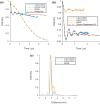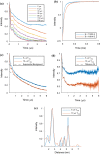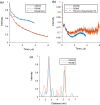DEER and RIDME Measurements of the Nitroxide-Spin Labelled Copper-Bound Amine Oxidase Homodimer from Arthrobacter Globiformis
- PMID: 34720439
- PMCID: PMC8550341
- DOI: 10.1007/s00723-021-01321-6
DEER and RIDME Measurements of the Nitroxide-Spin Labelled Copper-Bound Amine Oxidase Homodimer from Arthrobacter Globiformis
Abstract
In the study of biological structures, pulse dipolar spectroscopy (PDS) is used to elucidate spin-spin distances at nanometre-scale by measuring dipole-dipole interactions between paramagnetic centres. The PDS methods of Double Electron Electron Resonance (DEER) and Relaxation Induced Dipolar Modulation Enhancement (RIDME) are employed, and their results compared, for the measurement of the dipolar coupling between nitroxide spin labels and copper-II (Cu(II)) paramagnetic centres within the copper amine oxidase from Arthrobacter globiformis (AGAO). The distance distribution results obtained indicate that two distinct distances can be measured, with the longer of these at c.a. 5 nm. Conditions for optimising the RIDME experiment such that it may outperform DEER for these long distances are discussed. Modelling methods are used to show that the distances obtained after data analysis are consistent with the structure of AGAO.
Supplementary information: The online version contains supplementary material available at 10.1007/s00723-021-01321-6.
© The Author(s) 2021.
Figures





Similar articles
-
DEER-Stitch: combining three- and four-pulse DEER measurements for high sensitivity, deadtime free data.J Magn Reson. 2012 Oct;223:98-106. doi: 10.1016/j.jmr.2012.08.011. Epub 2012 Aug 21. J Magn Reson. 2012. PMID: 22975240
-
RIDME distance measurements using Gd(iii) tags with a narrow central transition.Phys Chem Chem Phys. 2016 Jul 28;18(28):19037-49. doi: 10.1039/c6cp03299k. Epub 2016 Jun 29. Phys Chem Chem Phys. 2016. PMID: 27355583
-
Pulsed EPR Methods to Study Biomolecular Interactions.Chimia (Aarau). 2019 Apr 24;73(4):268-276. doi: 10.2533/chimia.2019.268. Chimia (Aarau). 2019. PMID: 30975255
-
Orthogonal spin labeling and pulsed dipolar spectroscopy for protein studies.Methods Enzymol. 2022;666:79-119. doi: 10.1016/bs.mie.2022.02.004. Epub 2022 Mar 17. Methods Enzymol. 2022. PMID: 35465930 Review.
-
RIDME Spectroscopy: New Topics Beyond the Determination of Electron Spin-Spin Distances.J Phys Chem Lett. 2025 Jan 30;16(4):1024-1037. doi: 10.1021/acs.jpclett.4c02667. Epub 2025 Jan 22. J Phys Chem Lett. 2025. PMID: 39841411 Free PMC article. Review.
Cited by
-
EPR Spectroscopy Provides New Insights into Complex Biological Reaction Mechanisms.J Phys Chem B. 2022 Oct 6;126(39):7486-7494. doi: 10.1021/acs.jpcb.2c05235. Epub 2022 Sep 22. J Phys Chem B. 2022. PMID: 36137278 Free PMC article. Review.
-
Design of the elusive proteinaceous oxygen donor copper site suggests a promising future for copper for MRI contrast agents.Proc Natl Acad Sci U S A. 2023 Jul 4;120(27):e2219036120. doi: 10.1073/pnas.2219036120. Epub 2023 Jun 26. Proc Natl Acad Sci U S A. 2023. PMID: 37364102 Free PMC article.
-
Modelling Conformational Flexibility in a Spectrally Addressable Molecular Multi-Qubit Model System.Angew Chem Int Ed Engl. 2022 Nov 7;61(45):e202207947. doi: 10.1002/anie.202207947. Epub 2022 Oct 12. Angew Chem Int Ed Engl. 2022. PMID: 36222278 Free PMC article.
-
Chemical tuning of quantum spin-electric coupling in molecular magnets.Nat Chem. 2025 Aug 27. doi: 10.1038/s41557-025-01926-5. Online ahead of print. Nat Chem. 2025. PMID: 40866610
-
Structure and dynamics determine G protein coupling specificity at a class A GPCR.Sci Adv. 2025 Mar 21;11(12):eadq3971. doi: 10.1126/sciadv.adq3971. Epub 2025 Mar 19. Sci Adv. 2025. PMID: 40106559 Free PMC article.
References
-
- D. Goldfarb and S. Stoll, EPR Spectroscopy: Fundamentals and Methods. 2018: Wiley.
Grants and funding
LinkOut - more resources
Full Text Sources
Miscellaneous
